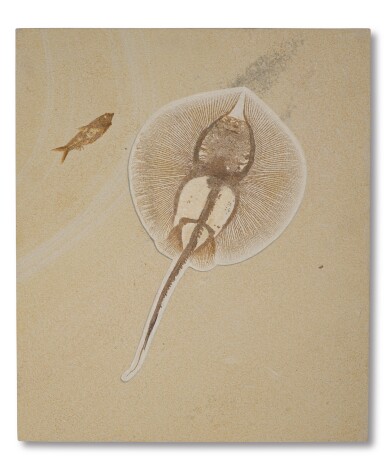Natural History
Natural History

Fossil Stingray with Fish
Early Eocene (approx. 56 - 48 million years ago), Green River Formation, Kemmerer, Wyoming
Auction Closed
July 26, 08:15 PM GMT
Estimate
4,000 - 6,000 USD
Lot Details
Description
Fossil Stingray with Fish
Heliobatis radians, Knightia eocaena
Early Eocene (approx. 56 - 48 million years ago)
Green River Formation, Kemmerer, Wyoming
Stingray measures 15 x 8½ inches (38.1 x 21.6 cm). 20 x 17⅛ x ⅞ in (50.8 x 43.5 x 2.22 cm) in matrix. 20 pounds (9.07 kg).
This well-preserved skeleton (cartilaginous) is beautifully prepared, and exposes the male claspers and stingers on the tail. Also preserved together is another skeleton of an extinct herring like fish with its right side exposed. Nice example of the fine preservation that exists in the ancient lake deposit of the Green River Formation.
Heliobatis is an extinct genus of freshwater stingray equipped with modified dermal denticles that formed barbed stingers at the ends of their long tails, which could comprise up to half of their total body length. Their teeth were adapted to prey on other benthic and demersal zone creatures including mollusks, crustaceans, and small fish, including the Knightia eocaena specimen featured alongside this fossil stingray.
Approximately 50 million years ago, Heliobatis thrived in the Green River Formation, an area that comprised more than 25,000 square miles (65,000 sq. km) of interconnected subtropical lakes spread across the current states of Wyoming, Utah, and Colorado. Today, the region of the Green River Formation known as "Fossil Lake" boasts some of the most abundant and well-preserved freshwater fossils anywhere in the world, including the Heliobatis and Knightia specimens offered here.
